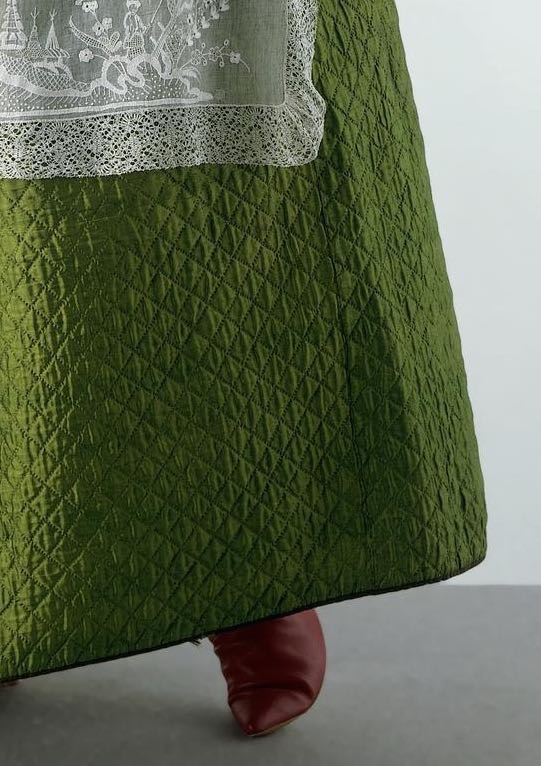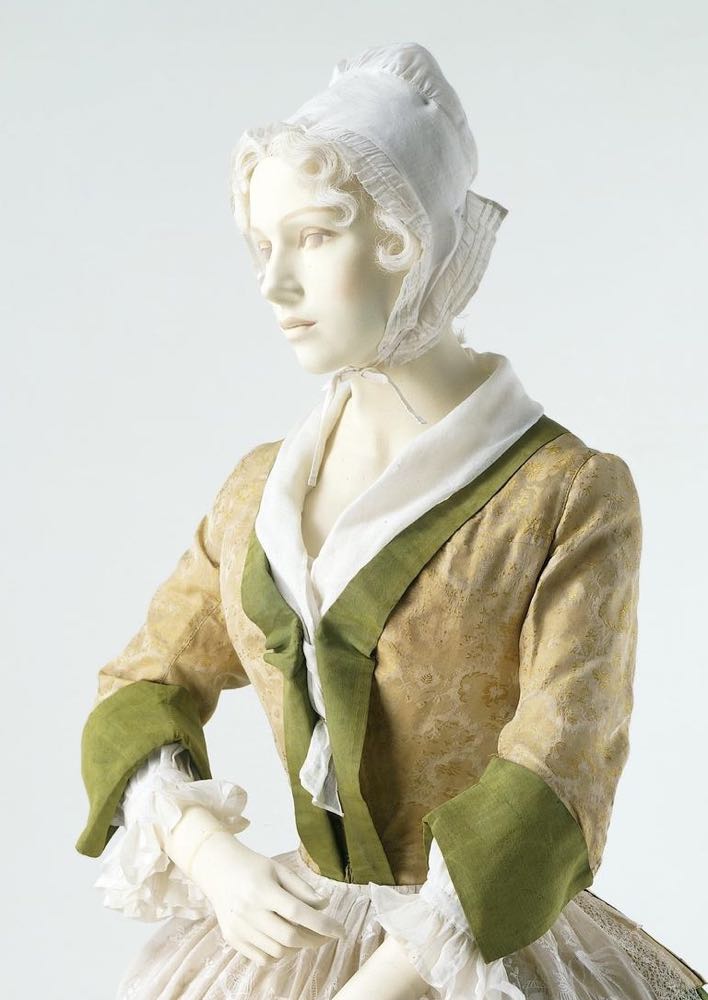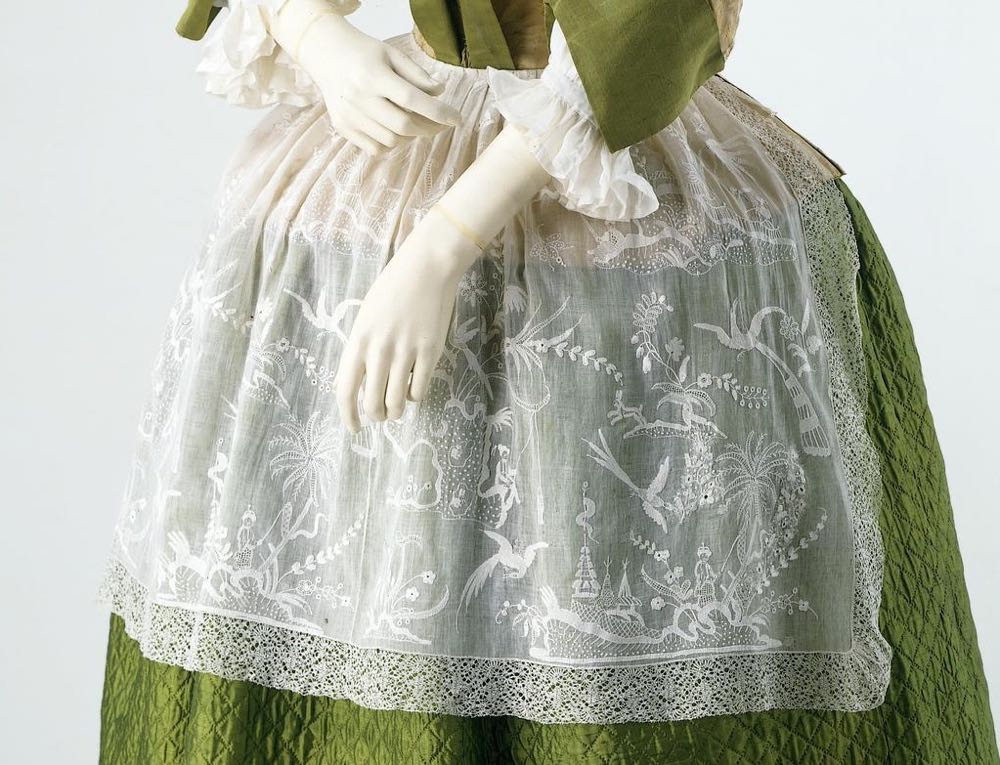Last week I showed a Finnish evening dress from 1912, which appeared sage green in the photos available. I was pleasantly surprised by how much you liked the dress – I thought it was nice, with some fabulous trim work, but not exceptional for its era, but absolutely everyone rated it higher than I would have. Hurrah! So the dress achieved an impressive 9.2 out of 10.
In contrast to last week’s gala dress, this week’s ensemble is an informal indoors affair, consisting of a jacket, quilted petticoat, and embroidered apron, all from the first half of the 18th century.

Quilted petticoat, silk and wool, England, 1740-50, T.306-1982, Jacket, silk and linen, unknown, 1720-30 of 17th century silk, T.264-1958, Apron, cotton with whitework embroidery, England (embroidery), Flanders (lace), 1720-40, T.9-1952, ©Victoria and Albert Museum, London
Intriguingly, the jacket is made from 17th century silk, and may possibly be a re-make of an earlier garment.
Whilst this style of outfit was intended for informal indoors wear amongst the upper classes, the apron, elaborately embroidered with Chinoiserie motifs, was clearly intended to impress, both for the skill of the embroidery, and for the knowledge and worldliness the pattern implied.
The quilted petticoat was a very popular garment throughout the 18th century, providing warmth and ease of movement. The simple lattice-work pattern of this example isn’t as elaborate as some, but provides a suitable backdrop for the apron, and the sheen of the green silk would have reflected candlelight beautifully.

Quilted petticoat, silk and wool, England, 1740-50, T.306-1982, ©Victoria and Albert Museum, London.
What do you think? It’s an outfit that was intended to be attractive, and enviable, while still giving an overall air of simplicity. Has it worked?
Rate the Dress on a Scale of 1 to 10



10 out of 10.
No question. I love the green silk, and really like that the jacket silk is possibly re-used from an older garment. The cut of the jacket is so flattering, so wearable, and I love quilted petticoats. The apron is a star. So pretty, and to me anyway, funny. An apron is designed to protect the garment underneath, to be more durable and washable. Here, the woman shows her wealth and status by wearing an anti-apron, much more delicate and precious than even the lovely silk underneath it.
Quite charming!
It’s also possible that aprons covered stains on a garment, since the lap of a skirt is a common place for stains even if you are not cooking or working. A pretty apron could have been a way to dress up your outfit and get more wear out of a stained skirt.
Perhaps this apron is similar to hostess aprons of the 1950s: Meant to be pretty and statement making, not to be useful.
10 out of 10 for me, too. I love green and yellow and white. I love simple and elegant garments. And it’s just the time of year to want a warm and simple skirt with a jacket and nice big cuffs.
I love everything (not Roccoco) from the 18th century!
10!
I love the green, quilted skirt; it’s absolutely beautiful. And I like the green velvet edging the jacket, as well as the combination of edging and jacket. Though it looks to me almost as though the velvet trim is only pinned on, and is not an actual or even original part of the jacket–is that true? And the apron is exquisite; delicately worked, beautifully trimmed and embroidered, and in amazing condition!
Anyway, assuming that the jacket is now as it was meant to be worn back then, my only quibble with the outfit is that the apron is so sheer it looks a bit odd, being tied on over the peplum of the jacket. Aprons in general may have been worn that way in period (I can’t recall) but it looks strange because the colors of jacket and skirt are different and thus show through differently. Otherwise, a beautiful though simple outfit. A 9.5 out of 10.
I read the green facings as a plain weave silk – if you click through the link you can see a really large format picture. And the description for the jacket states silk facings, so I think they are original to it. It is hard, this squinting at images!
Another 10 of 10. The quilted skirt is my favorite shade of green, and the jacket coordinates most pleasingly. The apron is an absolute stunner.
I wonder how they know that the apron was meant to be worn with this garment. I am blown away how something so delicate could have survived so long and in such pristine condition. I just find i hard to believe that it would have been worn over that outfit. It’s at odds with the jacket shape. Wearing it under the jacket would mean losing lots of the embroidery. Was this a Thing?
But I love the green outfit. I can’t get past my distaste of sheer aprons – to me they are such a F**K you to all of the women who worked their guts out in real work clothes. Overtones of Marie Antoinette playing milk maid. But then who am I to judge when so much of what I consume is probably made in horrendous conditions overseas. And the embroidery is amazing.
7/10 because the conflicted feelings I have about it don’t add up to a good thing and take away from my enjoyment of it.
I’m a 10/10 on this one. I really love more everyday clothing, and this is a time period I really like to see. Ballgowns can be fun to look at, but daywear really shows how people lived. I may add this to my “I want to create” list.
I love it all except the shape of the skirt. I’ve never liked round skirts descending from what I assume is some kind of hoop. It reminds me of the late Elizabethan style although it’s not quite as bad as that!
Still, I love everything else. The green silk is beautiful and the jacket has a sort of elegant simplicity about it. The apron is very pretty as well. 9/10
The quilted petticoat reminds me of the one in the Canterbury Museum. It is displayed as a dress – and isn’t because it was from our family and we know. Can I give the apron 12/10?
I love Maryanne’s comment about the apron and agree wholeheartedly with the middle finger to the ladies who needed the apron to work and not for decoration. That said, it is lovely. Any idea how the skirt itself is gathered or pleated? I’m in the process of building a 1740s gown now and how to gather or pleat the skirt is driving me batty. 🙂 I’ll also go 8/10.
Embroidery aprons like that are such a marker of wealth, since they only protect the skirt from stray bits of silk! Very much a status sign. She would be nowhere near the kitchen. Overall, it’s a 9.5 for me. The pattern on the silk jacket isn’t a home run, but all that colour and detail screams wealthy woman at home. I adore the quilted petticoat especially.
It’s subtle, restful and comfortable. Warm and snuggly. Not a show-stopper, the apron aside, but a deeply charming ensemble that just feels so restful and reassuring. The apron is exquisite. I know the V&A were trying to present ensembles as they would have been put together at the time, based on reference images and research, so while the pieces didn’t originally go together, they were hopefully going to look like they might have been worn that way originally.
7.5/10 for me, as while it’s nice, it isn’t really knocking me out, apron aside – I really like it overall, though!
The proportions strike me as a bit jarring and wonky, but that may be because I’m less familiar with this period/generally don’t like this style as much as others.
Otherwise, this is very very lovely, especially the quilted green petticoat – it’s dark but so luminescent; even though it’s all one color, it still has dimension.
The cut and colors of the jacket complement the apron – I don’t know much of anything about historic Chinese clothing and can only speak generally, but the wide sleeves and broad contrasting trim seem to mimic the Chinese garments Westerners would have been familiar with.
That and reading Maryanne’s comment does make me look at it differently though – less a lovely outfit and more of a lovely costume with a fair amount of posturing involved.
The apron is gorgeous, but I think for me the real appeal is that petticoat.
7.5/10
I´m thinking about possibility that jacket is not mounted on figurine correcty. Robbings have unnatural angle and looks almost like they are going to tear. May be it as worn with gap between robbing filled with stomacher, waht do you think?
In any case, 1740´s is my favourite period, i love green and this apron is absolutely wonderfull – so 10/10.
“You have such a lovely dress, my dear Mistress Bennet!” 9/10
10/10. Costume from this period rarely ‘floats my boat’ but the style of the bodice and the lovely shade of green won me over.
The top and bottom feel incongruous. 5/10.
Oh, totally 10/10. I would wear the heck out of this…it has everything that is great about my favorite era. The shift with the ruffly sleeves is a no for me but I think they were just trying to have some kind of visible undergarment.
This is such a clean, simple look. The green quilted silk petticoat is just beautiful. I wish the green of the facings was either closer to that of the petticoat, or else much lighter. But it looks just right with the light gold of the jacket. And really, for items that didn’t start out together, it looks good. I’d like to see the pattern of the jacket silk close-up. The front doesn’t seem to be sitting quite right on the mannequin. And the ruffled sleeves don’t look right under the jacket, to me. I think the cap is charming. No idea if it’s correct for the rest of the outfit.
And now that beautiful apron! It looks so fresh, almost as if it was new! The embroidery design manages to look elegant, feminine, and rather frivolous all at once. It’s very interesting to see this sort of design in such light, delicate whitework, rather than many colors, or blue and white. I’d like a closer look at the lace. The effect of the apron worn over two colors, with the jacket underneath creating a bit of a ridge, is a little odd, and rather distracts when looking at the embroidery design. 8.5 because the few things that are a little off detract from the initial impression.
I’ve just had a closer look at the apron photos, and realized it doesn’t quite look new. It’s still amazing that such delicate fabric is in this condition after almost 300 years. And I’m rather intrigued that the embroidery pattern is repeating, and seems to have been done in two separate panels which were joined to make the apron. You can see a bit of flower and curly stem which aren’t quite matched at the seam. And now I see a palm tree, and am even more interested in what region this might portray.
It works for me. I love the quilted skirt and the jacket and the way the different fabrics work together. I’m very much tempted to make reconstructions of these items.
In general I’m not a fan of impractical lace aprons, because I think they look silly. However, I’ve decided to give this one a pass because of the statement it makes about the owner’s level of knowledge. 10/10
9/10. I like it almost in its entirety, but the lines of the skirt irritate me somehow. The rest is very good.